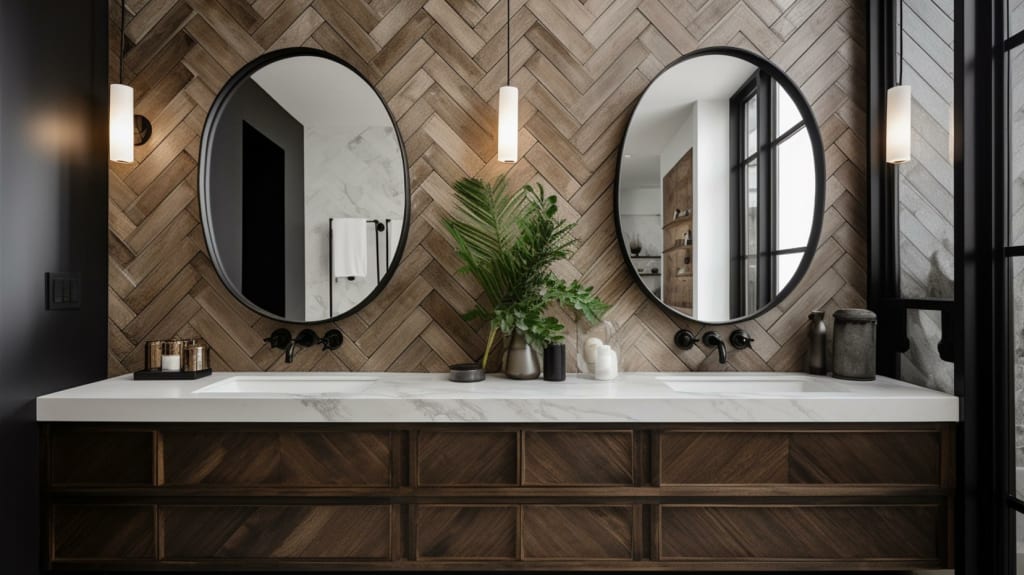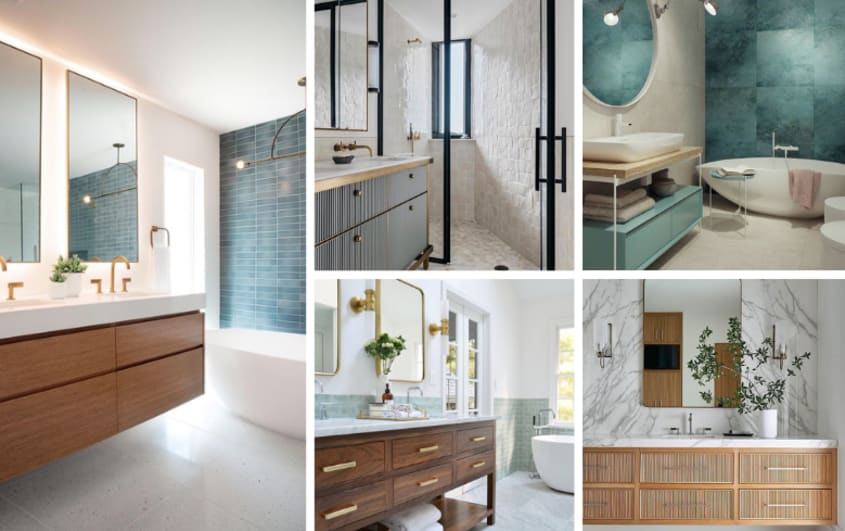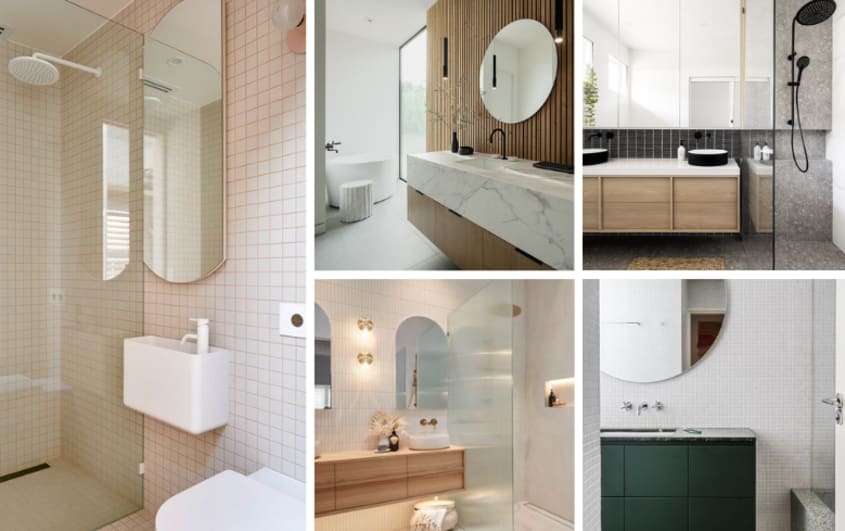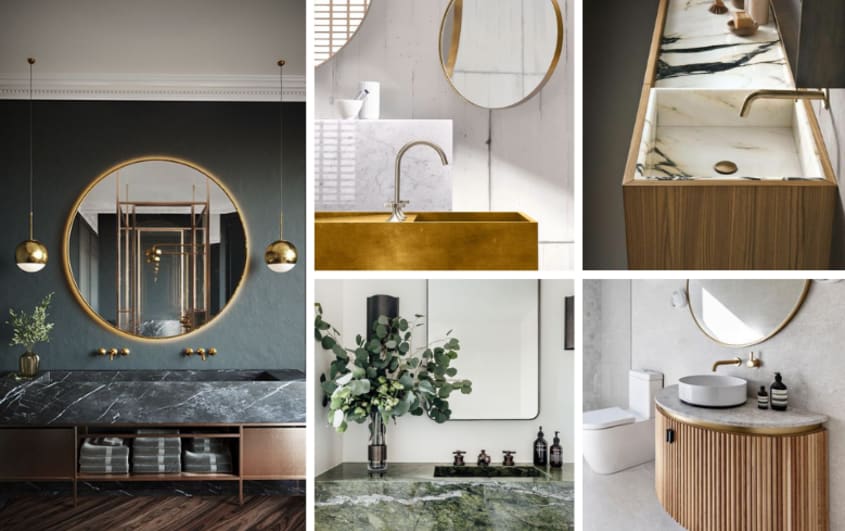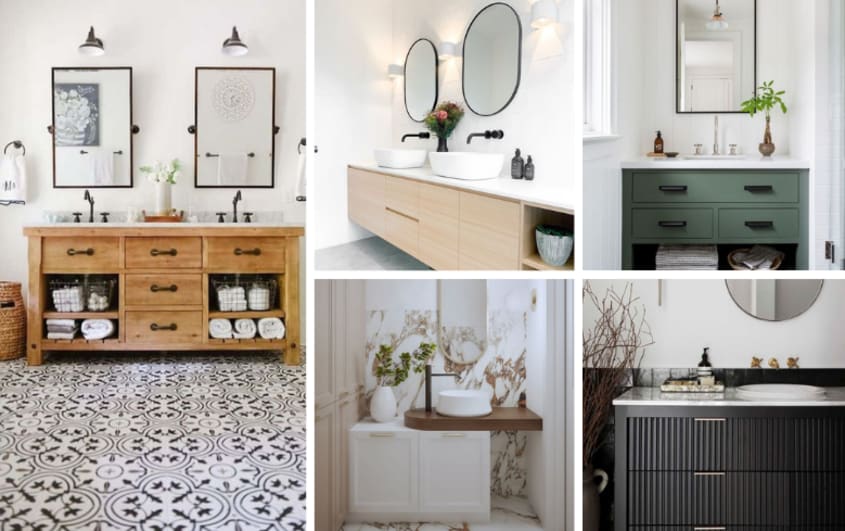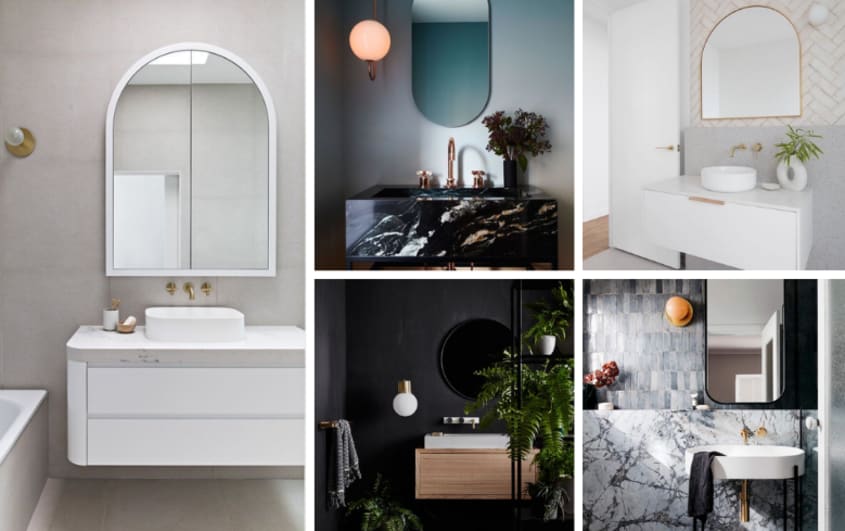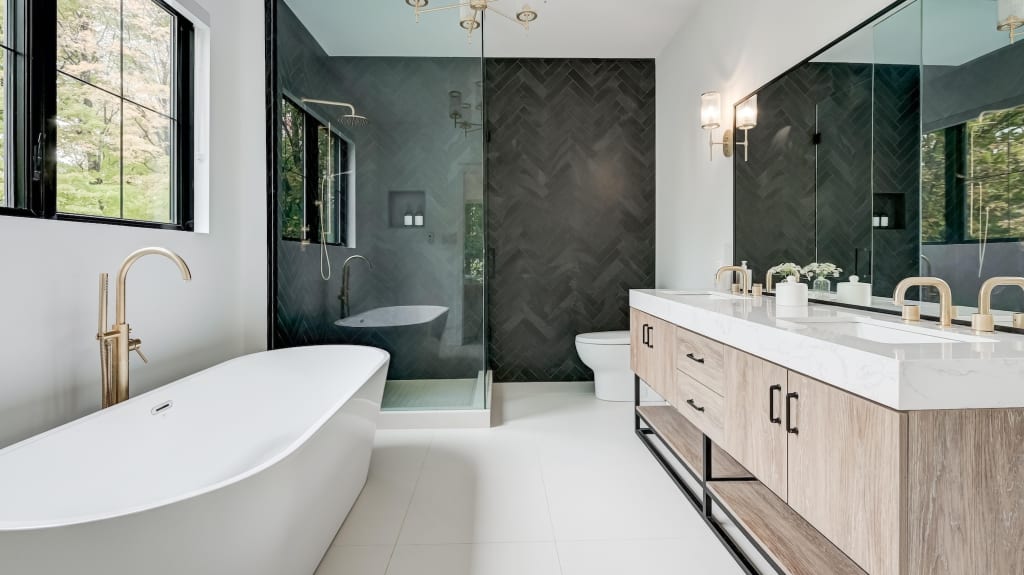When renovating your bathroom, you want to ensure that the style and the construction are exactly what you want. Focal points like showers, bathtubs, and vanities strongly influence the look and feel of your space. Bathroom vanities come with endless options for customization, allowing you to create whatever you desire. While this gives you a lot of creative freedom, a plethora of options can also be overwhelming or confusing. Do you want a small vanity? Are you aiming for a modern look? Is there enough storage space for you? Read through this bathroom vanity guide and get a good idea of what you want before you spend time searching for the vanity that is right for you.
Choosing the best bathroom vanity for your home
Style, functionality, materials… there are several elements you need to consider when choosing the right bathroom vanity for your space. For example, you might choose a sleek floating double vanity in a large and luxurious bathroom and a pedestal sink in a tiny bathroom where space is at a premium. Here are some things to think about when hunting for the perfect vanity.
Space. Should you have the space, you can get a large and deep vanity that allows for more storage options and customization. For smaller bathrooms, a sink that doesn’t obstruct your line of sight and takes up less space is the better option.
Material. What is used to construct your vanity impacts the look, durability, and maintenance required. It can also impact installation. For instance, a tiled countertop is DIY friendly, but a concrete countertop must be installed on site by professionals. Your desired aesthetic should impact your choices when picking materials.
Vanity side and backsplash. If your bathroom vanity is against the wall, you may want a backsplash or side splash installed. This won’t be necessary for standalone vanities and tiled walls.
Hardware and accessories. Cabinet knobs and pulls are small but powerful accents that come in countless shapes and colours, so you can pick just the right style for your bathroom vanity. Accessories like towel bars, toilet roll holders, and baskets can customize your space even further.
Faucets. Vanities typically have predrilled holes that determine if you’ll need to install a single-handle, centerset, or widespread faucet. Thankfully, style and finish are not restricted, so you can still achieve your desired aesthetic.
Storage. When picking a vanity, consider your storage needs. Vanities have many options, such as drawers, cabinets, pullouts, and even built-in towel rods. The storage solutions you pick should meet the needs of who will be using the space. For example, shared and primary bathrooms need far more storage space than a guest bathroom that gets used less frequently.
Location. Where the plumbing is located in your bathroom restricts vanity choice, so make note of it when considering your options. For example, a corner vanity would require plumbing to be moved unless it is already located in the corner of your bathroom.
Each piece has many options for customization, though they may come with additional costs. Large vanities, intricate storage solutions, high-end hardware, and luxury materials can increase your costs significantly. Know what your budget is and familiarize yourself with bathroom renovation costs. Remember: You can get your dream vanity without breaking the bank.
Determine your style
When choosing your bathroom vanity, style is the most important factor. Maybe you love the feel of farmhouse and want to pick a solid wood cabinet with a warm stain and wrought iron hardware. Perhaps you’re going for a more modern vibe, so you want a smooth white stone console sink with polished steel legs, accented with a small mirror and lights above. If you’re a die-hard minimalist that wants an elegant space without clutter, you might go for a pedestal sink with a mirror and wall-mounted brush holder. Looking for inspiration? Browse through bathroom designs and the latest bathroom trends and decide what feels right for you.
Measure your space
Before going any further, you’ll need to measure your space so you know what can fit without compromising safety and accessibility. This will allow you to know what options are open for you when selecting your bathroom vanity type. Follow these tips to make the most of your bathroom, big or small.
Leave space for trim and door openings. Ensure that there’s enough space around the swing of any doors in the room, including existing cabinet and shower doors. Make sure there is space to move and use them once the vanity is installed, especially if you have any accessibility needs.
Be mindful of existing features. Any fixtures that need access after the vanity is installed should be noted, such as outlets and switches. Some vanities block the walls in the space they’re located while others don’t.
Check the plumbing location. Where the sink plumbing is located is important to note: it determines where your vanity should go. Moving plumbing is possible but is costly and requires a professional.
Standard compliance. There are standard requirements based on building code for vanity placement. They may vary by area, but most codes require at least 21” clearance in front of the vanity and 15” between the toilet and the bathroom vanity.
Height. Most vanities go from the ground up to 31”, though there are also 35” varieties. Mirrors, extra cabinetry, and lighting will likely be above this, so any obstructions should be measured.
Feel. Too many objects blocking your sight, even if meeting code, can feel very uncomfortable and restrictive. Smaller and less obstructive vanities are available should the space feel too cramped.
Bathroom vanity types
Choosing the right vanity type is based on many factors like size, storage, and style. Small freestanding, pedestal sink, narrow depth, and corner vanities are best for smaller spaces. For storage, vanity cabinets are king. That said, any vanity with shelves or drawers is great for storage.
Vanity cabinets
These vanities are very popular due to their convenient storage and extensive options for customization in size, design, and material. Since these cabinets come fully built, they can be installed easily. Just add a mirror and you’re done.

Freestanding vanities
These stand on the ground and are not attached to the wall in any way. You can choose from many different designs, both with and without storage space. They’re perfect for the DIYer in any household since installation is as easy as placing the vanity and connecting pipes.

Floating bathroom vanities
These are similar to cabinet vanities, but instead of having bases, they’re mounted to the wall. They tend to bring a more modern feel to the space.

Wall-mounted sink vanities
This sink is mounted directly to the wall with special brackets, and plumbing is visible from below. Common in older homes and apartments, this sink is great if your space or budget are limited.

Pedestal sink vanities
Consisting of a sink above an ornate pedestal, these give a very sleek appearance to your vanity. Available as one-piece units, or with the sink wall mounted and a separate pedestal base.

Narrow depth vanities
For the consumer needing space and storage in one, the narrow depth vanity is for you. They’re specially made to be thinner, often needing specialty faucets and/or sinks, but they give you far more space.

Corner bathroom vanities
These come in many varieties and usually have a small cabinet underneath. Designed to fit into the corner of your bathroom, this vanity is usually small and curved. It’s placed in smaller spaces where the plumbing is restricted to the corner.

Bathroom vanities without countertops
Most vanity types also can be purchased without a countertop, allowing for further customization. These are best for those who just need that specific countertop they’ve always wanted.

Console bathroom vanities
If you’ve ever asked yourself “What if my sink had legs?”, then this is for you. Console vanities take the form of a large freestanding or wall-mounted sink, supported by metal legs that go down to the floor. They usually have a built-in towel bar and lower shelf to store your bathroom supplies.

Build-to-fit (or custom) bathroom vanities
Do you want the perfect vanity to complete your luxury bathroom and have the budget for it? If so, you can get a vanity custom built into your space with whatever materials, colours, hardware, and accessories your heart desires. Much can be done by the intrepid DIYer, though some materials will require professional assistance.

Bathroom vanity cabinets
Now that you know the types of bathroom vanities, you can move on to cabinet materials, storage options, and hardware. If you aren’t planning to get cabinets, skip to the storage solutions section.
Cabinet materials
Your cabinets can be made with different materials, with price being influenced by strength and moisture resistance. You can achieve beautiful wood grain with veneer or solid wood, but solid wood will be much more durable and expensive. Though you have many options, most pre-built vanities are made with one of the most common materials.
Solid wood
Though they’re somewhat prone to warping, solid wood vanities are very resistant to water and are often stained to showcase the beautiful and natural wood grain. Some common types are oak and maple, which have good moisture resistance without being too expensive.

Rubberwood
Collected from plantation trees that have finished their lives producing rubber, this wood is an eco-friendly alternative to other solid woods. While cheap and durable, it tends to absorb moisture rapidly, which can lower its lifespan.

Particleboard
Particleboard is made up of small chips of wood that are glued together and compressed before veneer or laminate is applied on the outside faces. It’s inexpensive and readily available but compromises on strength and moisture resistance. It’s also an eco-friendly option since it’s made of wood scrap.

Medium density fibreboard (MDF)
This material is made up of compressed and glued paper fibers, resulting in a smooth board of similar density material all the way through. It’s easy to work with and finish, so it’s a popular material as well. That said, it’s extremely weak to water, but, if the edges are sealed properly, it can last for a long time. While MDF is easy to damage, it’s also easy to repair.

Plywood
Plywood is made up of multiple layers of wood glued together in alternating directions. This layering gives the wood superior strength and durability. That said, finishing is required to protect it from the elements. It’s relatively inexpensive, though more expensive than MDF or particleboard.

Cast polymers
Materials such as cultured marble and solid surface can be made by casting them in shape. This gives far more options for the look of your vanity and makes it essentially immune to moisture damage. That said, it’s far more expensive than most other options.
Finishes
Plywood, particleboard, and MDF all require finishing and there are multiple ways to achieve this.
Laminate
A plastic coating applied to the outside of wood products, laminate comes in many colours and designs, from wood look-a-likes to custom images. It protects the core material from water and is very durable.
Melamine
Melamine is similar to laminate but has a thinner plastic coating that rests on top of a sheet of decorative paper. It comes in a variety of options, from plain white to imitation wood and stone.
Veneer
Veneer is comprised of thin sheets of wood that are applied to the outside of other materials. It gives materials like plywood the beautiful look of wood grain at a fraction of the cost of solid wood, and it can be stained as well. Veneer is generally more expensive and less resistant to wear than laminates.
Paint
Some materials like MDF can be painted directly. Water resistant paint seals the material, protecting it, and comes in a variety of gorgeous colours.
Bathroom vanity storage solutions
There are lots of storage solutions and organizational tools out there to help arrange one’s personal effects. Here are some suggestions to help use all of your vanity’s space effectively.
Doors and drawers. Hidden just behind your vanity doors can be whatever you need, tucked just out of sight but still within reach.
Tilt-down drawers. This is a special kind of drawer that pulls out and then tilts partially downward so you can more easily access the contents.
Open shelves. When shelves are left open, their contents become a part of the design while being easily accessible.
Drawer organizers. Small, sectioned containers can help organize smaller items in your drawers so you can easily find what you need.
Tiered organizers. Frequently used for makeup, it organizes all of your countertop items in one place, keeping it neat and tidy.
Adhesive hooks and mounts. By placing adhesive hooks or mounts on the inside of doors, you can creatively store your hair styling products!
Boxes. A box on a shelf can store your linens, laundry, or luxuries. It’s flexible to suit your needs.
Pullout cabinet organization. Pullouts installed in cabinets can allow you to store all of your cleaning supplies in one place and access them easily.
Built-in towel bars. Some vanities come with towel bars, keeping your in-use linens close to the sink.
Bathroom vanity countertops
The countertop of your bathroom vanity is the centerpiece, so the material has to look right and hold up to constant use. Stone is a common choice because of its elegance, durability, and unique appearance. It instantly gives a feeling of prestige! Wood is also a fan favourite, with beautiful grain and a warmth that can’t be matched. Here are some quality materials to consider for your vanity.
Stone
Whether natural or cultured, stone is always a sleek and elegant choice. It works with any style but often creates a more modern feel.
Granite
A common natural stone, granite has high durability and water resistance when installed correctly. While generally a mottled orange colour, it can have grey or white within, occasionally being entirely white and grey. Its price is high to match its prestige.

Marble
Marble is known around the world for its white- and grey-streaked appearance. It’s strong and beautiful, though not as strong as granite. Its prices are largely based on the pattern in the stone, with whiter and more striking veins being far more expensive.

Quartz
Quartz is an engineered stone that has a surface finish similar to marble and granite but is much stronger and more affordable than both. It’s available in a variety of designs that can’t be found in nature and is a popular choice for countertops and flooring.

Soapstone
A more unusual stone for countertops, soapstone has a grey and black appearance, leaning more towards rustic and warm spaces. The surface doesn’t need to be sealed like other stone; however, it does have a soapy texture that may be uncomfortable to some. It’s a very strong material – it won’t chip – but it can scratch relatively easily. It’s similar in price to quartz.

Lava
Lava is a stone quarried directly from volcanic rock. It’s then glazed, fired, and cooled to create a variety of colours and web-like patterns. It’s stronger than all the other stone options, not susceptible to stains, and easily cleaned. The downsides are that it must be sourced separately from the vanity, and it is extremely expensive.

Wood
Wood makes us think of hearth and home and fits best into rustic and antique aesthetics. Since each piece of wood is unique, it offers visual and structural differences that add dimension and contrast to a space.
Solid wood
The most common version of wood countertops is made to look like butcher blocks of old. When properly sealed, they can last for a very long time. The appearance and cost are greatly influenced by the type of wood used.

Reclaimed wood
Reclaimed wood countertops give new life to old lumber – they’re crafted by either repurposing and refinishing old wood products or gluing together and sealing pieces of old wood. This creates an interesting look that adds a distinctly rustic touch to your bathroom. It’s more affordable than new lumber products and is eco-friendly!

Live edge
A single piece of wood with a natural edge that showcases the outer rings of the tree, live edge countertops are a unique statement piece. They show the age of the tree as well as all of its imperfections, something that’s not seen in traditional wood countertops. Keep in mind that the wood must be well sealed to protect it and live edge pieces can be quite expensive.

Bamboo
A rising material, bamboo grows extremely quickly and can be formed into any shape required. It always has the appearance of multiple boards attached together, with the growth bands visible along their length. It is quite strong, inexpensive, and eco-friendly, making it a popular option.

Other
Many other materials are available, each with their own benefits and drawbacks.
Concrete
Though very heavy, concrete is a strong and relatively inexpensive material that forms a smooth finish. Despite needing to be sealed and installed by a professional, it continues to grow in popularity.
Tile
If you’re looking to create your own unique design, a tiled countertop might be up your alley. It’s made by installing ceramic tiles on the base countertop material. Unfortunately, the finished surface is not smooth, grout can be hard to clean, and tiles tend to break easily. The price depends on what tiles are used.
Solid surface
Now a mainstay in kitchens and bathrooms, its smooth and uniform surface is a gorgeous addition to any room. It’s available in many colours, almost non-porous, and safe from staining. Prices are below stone but above laminate and tile, making it a popular choice.
Laminate
Able to mimic stone and wood surfaces, laminate is a common material for kitchen and bathroom countertops. It’s popular in part because it’s affordable and easily attached to other materials. While it’s not as durable as other countertop materials, it can still resist water if installed properly.
Recycled glass
Either seen as more traditional glass slabs or as colourful speckled designs, recycled glass uniquely shines. It is very durable, easy to clean, and eco-friendly. It should be installed by a professional to avoid chips and cracks, making it a bit of an investment.
Stainless steel
Steel can be shaped to fit around almost any countertop configuration desired and is impervious to water. While more eco-friendly and resistant to abrasion, it is about as expensive to install as marble and makes quite the sound if you aren’t careful.
Porcelain
Made by superheating clay-type materials, porcelain is beautiful, very strong, and extremely resistant to water. This smooth material may be difficult to acquire and costs about the same as stone countertops.
Resin
Epoxy resin countertops have been gaining popularity among DIY enthusiasts due to the flexibility of design and shape the material provides. That said, premade resin countertops can be quite costly, installation can be complicated, and maintenance is quite difficult.

Bathroom vanity sinks
Pre-built vanities are built to accommodate a certain type of sink – it’s listed in the product description. That said, all sink types serve their purpose, so pick your favourite style or aesthetic. Most sinks are cast iron with a ceramic coating, though other materials exist such as metal and composite resin.
Drop-in sinks
Drop-in sinks are the most common type of sink. The installation process is simple: simply drop it into a hole cut smaller than the sink’s rim and seal it. Lighter varieties are held in place by clamps (on the underside), while standard types stay in place due to their weight.

Framed sinks
Framed sinks are similar to drop-in sinks but have a metal “frame” under the rim as part of the sink. They’re easy to install and have a distinct look.

Under-mounted sinks
This sink is perfect for those who want a sleeker vanity design. An undermounted sink attaches to the underside of the counter, leaving a smooth and unobstructed top. It has a very modern design, though it usually leaves less space for storage and requires specialized countertops.

Vessel or deck-mounted sinks
The opposite of an under-mounted sink, a vessel sink sits on top of a countertop. These sinks are statement pieces and have become extremely popular in recent years due to their impressive design. They require specialized faucets and lower countertops to accommodate the sink’s height. It’s also available in semi-recessed versions.

Integral sinks
These sinks are shaped from the counter itself and are made of the same material. The countertop is seamless with no lip at the sink, creating an extremely sleek and modern look.

Console sinks
Similar to integral sinks, console sinks are a single piece featuring both the countertop and the sink. They are typically mounted on legs or the wall as part of a console vanity.

Bathroom vanity features
Picking the faucet, hardware, and accessories seems like a small piece of the puzzle, but these can be the accent that pulls your whole vanity together. From a brass and glass knob on an antique wood vanity to a brushed nickel towel rod attached to the side of a modern floating vanity, details are vital.
Faucets
What faucet you get will likely be determined by the top you select, as they generally come with pre-drilled holes in one of three patterns. If you’re getting a custom top or full vanity, you can select any of these.
Single-hole faucets
Installed in a single hole located behind the sink, this is the smallest type of faucet. It consists of a faucet and a single handle that controls both flow and temperature.

Centerset faucets
Similar to a single-hole faucet, a centerset faucet is also one piece. It’s installed into three holes: one centered hole and two adjacent holes 4” from the center. It consists of one faucet and two handles for flow and temperature adjustment.

Widespread mounts
A widespread mount features one faucet and two separate handles installed in three separate holes. There is one central hole for the faucet and two holes 6” from the center for the handles.

Wall mount faucets
In some cases you may want a faucet that isn’t attached to the top of your vanity, like when you have a vessel sink. A wall mount faucet is installed directly into the wall behind your sink, leaving your countertop clear. That said, it may require you to move plumbing and is generally incurs higher costs.

Faucet finishes
Faucets come in endless colours, styles, and finishes. From matte blacks to decorative ceramics, there’s something out there for everyone. So, take your time and find the faucet that fits your desired aesthetic.
If you’re looking for something timeless, go for brushed or polished metals. Browse different colours and sheens to find the perfect style for your bathroom. Keep in mind that, while polished faucets have a beautiful shine, each use will leave water stains. If you don’t want to be cleaning them constantly, consider opting for brushed metal, which is more forgiving.
Cabinet hardware
After you’ve chosen the perfect faucet, it’s time to accessorize your drawers. Depending on the style you’re going for, you can opt for matching or contrasting hardware. Most knob and pull styles come in a variety of finishes, which can change the final look drastically.
Pulls. These are made up of horizontal or vertical bars installed on the front of the cabinet. These are best for drawers as they match their rectangular shape. Longer pulls are typically used for wider drawers, but it’s best to install two pulls for anything past 8”.
Knobs. These handles are fastened through a single hole and are usually symmetrical. They’re best installed on doors, as their shape and size easily indicate which way the door swings. To maintain practicality and aesthetic, be sure to pick reasonably sized knobs for each door and drawer.
Accessories
When everything else has been decided, you need to make the space your own with accessories. Mix and match or create contrasting styles. Most accessories can be found with the same finishes you would find for your hardware, faucets, and vanity. Here are some options to consider.
Mirrors and medicine cabinets
Towel rods and rings
Toilet roll holders
Toothbrush holders
Wastebaskets
Laundry hampers
Cotton ball holders
Frequently asked questions
Looking for more information? Here are the most frequently asked questions about bathroom vanities.
What makes a good quality bathroom vanity?
A good quality bathroom vanity is made using good materials and is properly sealed to protect it from the moisture present in bathrooms. It must also be right for the people using it and the space it is fitting into.
Can you make your own bathroom vanity?
You can! If you need to scratch that maker itch, you can put together your very own custom vanity. Some material choices need professional installation, but you can pick your materials and build a bathroom vanity in any design you wish.
What type of wood is best for a bathroom vanity?
Teak is the best wood option by a landslide due to its extreme resistance to water and rot. That said, it’s expensive. More affordable alternatives would be maple, birch, and oak.
What is the most popular bathroom vanity colour?
In the lead by far is white, followed closely by ebony and grey.
What types of vanities would be best for a bathroom where space is limited?
The best options for small spaces are pedestal sinks, console sinks, wall mounted sinks, and corner vanities. The free sinks leave the space feeling very open and unobstructed and, if storage space is needed, a corner vanity offers a wonderful middle ground. There are many ways to make the most of your small bathroom.
Can bathroom vanities be recycled?
There may be recycling programs in your area, but not all areas have a method of recycling. Habitat for Humanity’s ReStore is one option – they’re a non-profit organization that will resell or reuse it.
Can used bathroom vanities be sold?
While vanities are often resold, gauging the market and dealing with potential buyers on platforms like Facebook Marketplace and Kijiji can be daunting. If you’re not up to investing the time or energy to sell your vanity, you can donate it or recycle it.
Can a bathroom vanity be resurfaced?
It depends on the material. Some countertops can be resurfaced, but all of them can be removed and replaced as needed.
Can you install lights on a bathroom vanity?
Yes, but it is not advised due to space restrictions and it being a high moisture area. Lights work better above the mirror or on the wall beside it.
Create the bathroom of your dreams
While there are many options for bathroom vanities, picking one doesn’t have to be overwhelming. If you go through the process step by step, you’ll find the vanity of your dreams in no time. Finding the style you like can be the hardest part, so get inspired by these bathroom ideas from our own projects!
